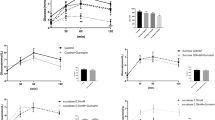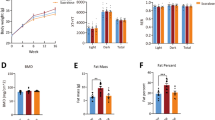Abstract
Objectives
Overconsumption of non-nutritive sweeteners is associated with obesity, whereas the underlying mechanisms remain controversial. This study aimed to investigate the effects of long-term consumption of nutritive or non-nutritive sweeteners with or without high fat diet on sweet taste receptor expression in nutrient-sensing tissues and energy regulation dependent on sweet-sensing.
Methods
50 Male Sprague–Dawley rats (140–160 g) were assigned to 10 groups (n = 5/group). All received fructose at 2.5% or 10%, sucralose at 0.01% or 0.015% or water with a normal chow diet or high fat diet for 12 weeks. Food and drink intake were monitored daily. Oral glucose tolerance test and intraperitoneal glucose tolerance test were performed at week 10 and 11 respectively. Serum was obtained for measurement of biochemical parameters. Tongue, duodenum, jejunum, ileum, colon and hypothalamus were rapidly removed to assess gene expression.
Results
Long-term consumption of sweeteners impaired glucose tolerance, increased calorie intake and body weight. A significant upregulation of sweet taste receptor expression was observed in all the four intestinal segments in groups fed 0.01% sucralose or 0.015% sucralose, most strikingly in the ileum, accompanied by elevated serum glucagon-like peptide-1 levels and up-regulated expression of sodium-dependent glucose cotransporter 1 and glucose transporter 2. A significant down-regulation in the tongue and hypothalamus was observed in groups fed 10% fructose or 0.015% sucralose, with alterations in hypothalamic appetite signals. The presence of high fat diet differentially modulates sweet taste perception in nutrient-sensing tissues.
Conclusions
Long-term consumption of whether nutritive sweeteners or non-nutritive sweeteners combined with high fat diet contribute to dysregulation of sweet taste receptor expression in oral, intestinal and central nervous tissues.








Similar content being viewed by others
Data availability
The datasets used and analysed in this current study are available from the corresponding author upon reasonable request.
Abbreviations
- AGRP:
-
Agouti-related peptide
- AUC:
-
Area under the curve
- GLP-1:
-
Glucagon-like peptide-1
- GLUT2:
-
Glucose transporter 2
- HFD:
-
High-fat diet
- IPGTT:
-
Intraperitoneal glucose tolerance test
- NCD:
-
Normal control diet
- NNS:
-
Non-nutritive sweetener
- NPY:
-
Neuropeptide Y
- OGTT:
-
Oral glucose tolerance test
- SGLT-1:
-
Sodium-dependent glucose cotransporter 1
- STR:
-
Sweet taste receptor
- T1R2:
-
Taste receptor type 1 member 2
- T1R3:
-
Taste receptor type 1 member 3
References
Bluher M (2019) Obesity: global epidemiology and pathogenesis. Nat Rev Endocrinol 15:288–298. https://doi.org/10.1038/s41574-019-0176-8
Febbraio MA, Karin M (2021) “Sweet death”: fructose as a metabolic toxin that targets the gut-liver axis. Cell Metab 33:2316–2328. https://doi.org/10.1016/j.cmet.2021.09.004
Hunter SR, Reister EJ, Cheon E et al (2019) Low calorie sweeteners differ in their physiological effects in humans. Nutrients. https://doi.org/10.3390/nu11112717
Pearlman M, Obert J, Casey L (2017) The association between artificial sweeteners and obesity. Curr Gastroenterol Rep 19:64. https://doi.org/10.1007/s11894-017-0602-9
Liem DG, Russell CG (2019) The influence of taste liking on the consumption of nutrient rich and nutrient poor foods. Front Nutr 6:174. https://doi.org/10.3389/fnut.2019.00174
Treesukosol Y, Smith KR, Spector AC (2011) The functional role of the t1r family of receptors in sweet taste and feeding. Physiol Behav 105:14–26. https://doi.org/10.1016/j.physbeh.2011.02.030
von Molitor E, Riedel K, Krohn M et al (2021) Sweet taste is complex: signaling cascades and circuits involved in sweet sensation. Front Hum Neurosci 15:667709–10. https://doi.org/10.3389/fnhum.2021.667709
Young RL, Sutherland K, Pezos N et al (2009) Expression of taste molecules in the upper gastrointestinal tract in humans with and without type 2 diabetes. Gut 58:337–346. https://doi.org/10.1136/gut.2008.148932
Hass N, Schwarzenbacher K, Breer H (2010) T1r3 is expressed in brush cells and ghrelin-producing cells of murine stomach. Cell Tissue Res 339:493–504. https://doi.org/10.1007/s00441-009-0907-6
Dyer J, Salmon KS, Zibrik L et al (2005) Expression of sweet taste receptors of the t1r family in the intestinal tract and enteroendocrine cells. Biochem Soc Trans 33:302–305. https://doi.org/10.1042/BST0330302
Ren X, Zhou L, Terwilliger R et al (2009) Sweet taste signaling functions as a hypothalamic glucose sensor. Front Integr Neurosci 3:12. https://doi.org/10.3389/neuro.07.012.2009
Medina A, Nakagawa Y, Ma J et al (2014) Expression of the glucose-sensing receptor t1r3 in pancreatic islet: changes in the expression levels in various nutritional and metabolic states. Endocr J 61:797–805. https://doi.org/10.1507/endocrj.ej14-0221
Masubuchi Y, Nakagawa Y, Ma J et al (2013) A novel regulatory function of sweet taste-sensing receptor in adipogenic differentiation of 3t3-l1 cells. Plos One 8:e54500. https://doi.org/10.1371/journal.pone.0054500
Hao S, Yang Y, Helmy M et al (2020) Neural regulation of feeding behavior. Adv Exp Med Biol 1284:23–33. https://doi.org/10.1007/978-981-15-7086-5_3
Kohno D (2017) Sweet taste receptor in the hypothalamus: a potential new player in glucose sensing in the hypothalamus. J Physiol Sci 67:459–465. https://doi.org/10.1007/s12576-017-0535-y
Steinert RE, Gerspach AC, Gutmann H et al (2011) The functional involvement of gut-expressed sweet taste receptors in glucose-stimulated secretion of glucagon-like peptide-1 (glp-1) and peptide yy (pyy). Clin Nutr 30:524–532. https://doi.org/10.1016/j.clnu.2011.01.007
DuBois GE (2016) Molecular mechanism of sweetness sensation. Physiol Behav 164:453–463. https://doi.org/10.1016/j.physbeh.2016.03.015
Laffitte A, Neiers F, Briand L (2014) Functional roles of the sweet taste receptor in oral and extraoral tissues. Curr Opin Clin Nutr Metab Care 17:379–385. https://doi.org/10.1097/MCO.0000000000000058
Thomson P, Santibanez R, Aguirre C et al (2019) Short-term impact of sucralose consumption on the metabolic response and gut microbiome of healthy adults. Br J Nutr 122:856–862. https://doi.org/10.1017/S0007114519001570
Morales-Rios EI, Garcia-Machorro J, Briones-Aranda A et al (2022) Effect of long-term intake of nutritive and non-nutritive sweeteners on metabolic health and cognition in adult male rats. J Med Food. https://doi.org/10.1089/jmf.2022.0016
Khan AS, Murtaza B, Hichami A et al (2019) A cross-talk between fat and bitter taste modalities. Biochimie 159:3–8. https://doi.org/10.1016/j.biochi.2018.06.013
Khorshidian N, Shadnoush M, Zabihzadeh KM et al (2021) Fructose and high fructose corn syrup: are they a two-edged sword? Int J Food Sci Nutr 72:592–614. https://doi.org/10.1080/09637486.2020.1862068
Martyn D, Darch M, Roberts A et al (2018) Low-/no-calorie sweeteners: a review of global intakes. Nutrients. https://doi.org/10.3390/nu10030357
Walbolt J, Koh Y (2020) Non-nutritive sweeteners and their associations with obesity and type 2 diabetes. J Obes Metab Syndr 29:114–123. https://doi.org/10.7570/jomes19079
Sanchez-Tapia M, Martinez-Medina J, Tovar AR et al (2019) Natural and artificial sweeteners and high fat diet modify differential taste receptors, insulin, and tlr4-mediated inflammatory pathways in adipose tissues of rats. Nutrients. https://doi.org/10.3390/nu11040880
Loney GC, Torregrossa AM, Smith JC et al (2011) Rats display a robust bimodal preference profile for sucralose. Chem Senses 36:733–745. https://doi.org/10.1093/chemse/bjr048
Boye A, Acheampong DO, Gyamerah EO et al (2020) Glucose lowering and pancreato-protective effects of Abrus precatorius (L.) leaf extract in normoglycemic and STZ/nicotinamide—induced diabetic rats. J Ethnopharmacol 258:112918. https://doi.org/10.1016/j.jep.2020.112918
Kim JY, Choi MJ, So B et al (2015) The preventive effects of 8 weeks of resistance training on glucose tolerance and muscle fiber type composition in zucker rats. Diabetes Metab J 39:424–433. https://doi.org/10.4093/dmj.2015.39.5.424
Zhang R, Zhou J, Li M et al (2014) Ameliorating effect and potential mechanism of Rehmannia glutinosa oligosaccharides on the impaired glucose metabolism in chronic stress rats fed with high-fat diet. Phytomedicine 21:607–614. https://doi.org/10.1016/j.phymed.2013.11.008
Shu Q, Chen L, Wu S et al (2020) Acupuncture targeting sirt1 in the hypothalamic arcuate nucleus can improve obesity in high-fat-diet-induced rats with insulin resistance via an anorectic effect. Obes Facts 13:40–57. https://doi.org/10.1159/000503752
Smith KR, Hussain T, Karimian AE et al (2016) Disruption of the sugar-sensing receptor t1r2 attenuates metabolic derangements associated with diet-induced obesity. Am J Physiol Endocrinol Metab 310:E688–E698. https://doi.org/10.1152/ajpendo.00484.2015
Young RL (2011) Sensing via intestinal sweet taste pathways. Front Neurosci 5:23. https://doi.org/10.3389/fnins.2011.00023
Kreuch D, Keating DJ, Wu T et al (2018) Gut mechanisms linking intestinal sweet sensing to glycemic control. Front Endocrinol (Lausanne) 9:741. https://doi.org/10.3389/fendo.2018.00741
Qian C, Qi YC, Feng RL et al (2021) Sucralose can improve glucose tolerance and upregulate expression of sweet taste receptors and glucose transporters in an obese rat model. Eur J Nutr 60:1809–1817. https://doi.org/10.1007/s00394-020-02375-1
Song X, Wang F, Xu H et al (2019) 3-deoxyglucosone induces glucagon-like peptide-1 secretion from stc-1 cells via upregulating sweet taste receptor expression under basal conditions. Int J Endocrinol 2019:4959646. https://doi.org/10.1155/2019/4959646
Ohtsu Y, Nakagawa Y, Nagasawa M et al (2014) Diverse signaling systems activated by the sweet taste receptor in human glp-1-secreting cells. Mol Cell Endocrinol 394:70–79. https://doi.org/10.1016/j.mce.2014.07.004
Nguyen NQ, Debreceni TL, Bambrick JE et al (2015) Accelerated intestinal glucose absorption in morbidly obese humans: relationship to glucose transporters, incretin hormones, and glycemia. J Clin Endocrinol Metab 100:968–976. https://doi.org/10.1210/jc.2014-3144
Jang HJ, Kokrashvili Z, Theodorakis MJ et al (2007) Gut-expressed gustducin and taste receptors regulate secretion of glucagon-like peptide-1. Proc Natl Acad Sci USA 104:15069–15074. https://doi.org/10.1073/pnas.0706890104
Margolskee RF, Dyer J, Kokrashvili Z et al (2007) T1r3 and gustducin in gut sense sugars to regulate expression of na+-glucose cotransporter 1. Proc Natl Acad Sci USA 104:15075–15080. https://doi.org/10.1073/pnas.0706678104
Kellett GL, Brot-Laroche E (2005) Apical glut2—a major pathway of intestinal sugar absorption. Diabetes 54:3056–3062. https://doi.org/10.2337/diabetes.54.10.3056
Herrera MCD, Argmann C, Van Eijk M et al (2016) Impact of obesity on taste receptor expression in extra-oral tissues: emphasis on hypothalamus and brainstem. Sci Rep 6:29094. https://doi.org/10.1038/srep29094
Zhao X, Yan J, Chen K et al (2018) Effects of saccharin supplementation on body weight, sweet receptor mRNA expression and appetite signals regulation in post-weanling rats. Peptides 107:32–38. https://doi.org/10.1016/j.peptides.2018.07.006
Schneeberger M, Gomis R, Claret M (2014) Hypothalamic and brainstem neuronal circuits controlling homeostatic energy balance. J Endocrinol 220:T25–T46. https://doi.org/10.1530/JOE-13-0398
la Fleur SE, van Rozen AJ, Luijendijk MC et al (2010) A free-choice high-fat high-sugar diet induces changes in arcuate neuropeptide expression that support hyperphagia. Int J Obes (Lond) 34:537–546. https://doi.org/10.1038/ijo.2009.257
Guerra-Cantera S, Frago LM, Collado-Perez R et al (2021) Sex differences in metabolic recuperation after weight loss in high fat diet-induced obese mice. Front Endocrinol (Lausanne) 12:796661–8. https://doi.org/10.3389/fendo.2021.796661
Kohno D, Koike M, Ninomiya Y et al (2016) Sweet taste receptor serves to activate glucose- and leptin-responsive neurons in the hypothalamic arcuate nucleus and participates in glucose responsiveness. Front Neurosci 10:502. https://doi.org/10.3389/fnins.2016.00502
Funding
No.
Author information
Authors and Affiliations
Contributions
The authors’ responsibilities were as followed. YZ and HD designed research; YZ, LC, JG, YC, FL, XB conducted research; YZ and HD analyzed data; YZ wrote the paper; YZ and HD had primary responsibility for the final content. All authors read and approved the final version of the paper.
Corresponding author
Ethics declarations
Conflict of interest
Y. Zhang, L. Chen, J. Gao, Y. Cheng, F. Luo, X. Bai, H. Ding, no conflicts of interest.
Supplementary Information
Below is the link to the electronic supplementary material.
Rights and permissions
Springer Nature or its licensor (e.g. a society or other partner) holds exclusive rights to this article under a publishing agreement with the author(s) or other rightsholder(s); author self-archiving of the accepted manuscript version of this article is solely governed by the terms of such publishing agreement and applicable law.
About this article
Cite this article
Zhang, Y., Chen, L., Gao, J. et al. Nutritive/non-nutritive sweeteners and high fat diet contribute to dysregulation of sweet taste receptors and metabolic derangements in oral, intestinal and central nervous tissues. Eur J Nutr 62, 3149–3159 (2023). https://doi.org/10.1007/s00394-023-03187-9
Received:
Accepted:
Published:
Issue Date:
DOI: https://doi.org/10.1007/s00394-023-03187-9




